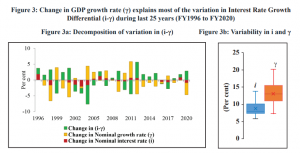
The US Federal Reserve on Wednesday hinted that it may raise interest rates in March and said it would also end its bond purchases to tame inflation. The US central bank had cut interest rates to near-zero levels after the Covid-19 pandemic hit the country in March 2020. It also started pumping money into the financial system to ensure financial stability. These steps pushed inflation to 7% while bringing the unemployment rate to pre-pandemic levels. Now Fed seems to have enough room to hike interest rates without fear of job losses.
Inflation continues to be a headache for policy makers and political leaders alike globally. India is no different. This topic is as much related to economics and business as it is to politics. How can India safeguard itself from the spectre of hyperinflation?
The country’s retail inflation, measured by the Consumer Price Index (CPI), increased to a five-month high of 5.59 % in December 2021. This is still within the Reserve Bank of India’s comfort level of 6%. It was only in 2014 that India switched to CPI instead of using the wholesale price index or WPI.
READ I Budget 2022: India should spend its way out of post-Covid economic crisis
Inflation testing RBI’s comfort zone
The Union government has mandated the Reserve Bank to maintain retail inflation at 4%, with a margin of plus/minus 2%, for a five-year period ending in March 2026. The range of CPI inflation (4% to +/- 2%) is not the only target that the RBI is concerned with. It also considers the output gap or the gap between the actual GDP and potential GDP.

The current surge in inflation is due to a number of factors on both the demand and supply sides. The growth rebound following the sharp fall in GDP and employment due to the onset of Covid-19 should not have caused such a big rise in inflation numbers if there were no supply bottlenecks.
Another economic indicator is the factory output, measured in terms of the index of industrial production (IIP), which witnessed a growth of 1.4% in November 2021. The increasing inflationary trend would be a challenge to balance as India gets ready to increase the speed of economic activity. On February 1, the Union Budget 2022 will give us an idea about the fiscal roadmap for the financial year 2022-23.
READ I Indian markets await cues from Budget 2022, Fed stance
Covid-19 hits growth prospects
Just when the second wave of Covid-19 which hurt both lives and livelihood was over, we were pushed back by the newer variant. While many claim that it is less physically intense, it is too early to pass judgement without data collation and research. Any long-term health issues related to the third wave may dent our healthcare budget as well as industrial productivity. The impact on mental health and its correlation to workforce efficiency and burnout issues is yet to be factored in.
The multiple waves of Covid have impacted supply chains across sectors. This has added to the costs, leading to inflationary pressure. The fear of supply side inflation is lurking. For example, we have seen a global shortage of semiconductor chips that has hurt many sectors including automobiles, consumer electronics, and computing devices.
Reducing our dependence on imports from developed economies might reduce our inflationary pressure. In developed economies, labour costs have spiralled up. In turn, this has affected pricing of imports undertaken and hence the landed cost of imported finished goods or even imported inputs for Indian manufactured goods has increased.
READ I Budget 2022: India should spend its way out of post-Covid economic crisis
Rise in prices of essential items
The prices of petrol, diesel, cooking gas, and edible oils are at all-time highs. Despite the global crude prices increasing, Indian oil majors seem to have a soft-freeze of fuel prices currently. Market punters believe that this is in view of the upcoming assembly elections where increasing inflation and unemployment issues could come up.
This speculation is not without basis as fuel retail companies revised prices almost daily last calendar year. The price of fuel and power have risen nearly 40% between November 2020 and November 2021. When economies get into recessionary mode and prices fall, demand could jump back in oil and metals. The increased demand could also see increase in prices again.
Crop output and crop failures are nature-based inflation variables. These impact food availability and consequently prices of pulses and edible oils, leading to high food inflation. Controlling these two numbers becomes necessary from a political outcome perspective as well. Hence the decision taken in December 2021 to ban agricultural futures trading contracts is critical to stem inflationary trends.
The Indian economy is in recovery mode but growth is worryingly concentrated at the top end. The bigger question of a section of experts is whether the lower social spectrum of the Indian economy is stagnating or in recession. The market guess is that the RBI is not reacting by tightening monetary policy to control inflation as it could slow or even hurt economic recovery. However, if inflation moves towards the 6% mark, the RBI may be left with no choice but to tighten its monetary policy stance.
On the bond market front, the RBI has been working to sweep up liquidity and consequently the long-term bond yields have inched upwards. The government is an active borrower on the domestic debt markets and any action or inaction on its part will have consequences for itself and the economy.
Credit access to all sectors, especially the middle and lower rungs of industries including SMEs and MSMEs, needs to push towards gainful entrepreneurship. In short, if India can work on food output (to keep prices under check), industrial output, and credit offtake for businesses, it can possibly tame the spectre of inflation.
Srinath Sridharan is a strategic counsel with 25 years experience with leading corporates across diverse sectors including automobiles, e-commerce, advertising and financial services. He understands and ideates on intersection of finance, digital, contextual-finance, consumer, mobility, Urban transformation, and ESG. Actively engaged across growth policy conversations and public policy issues.

